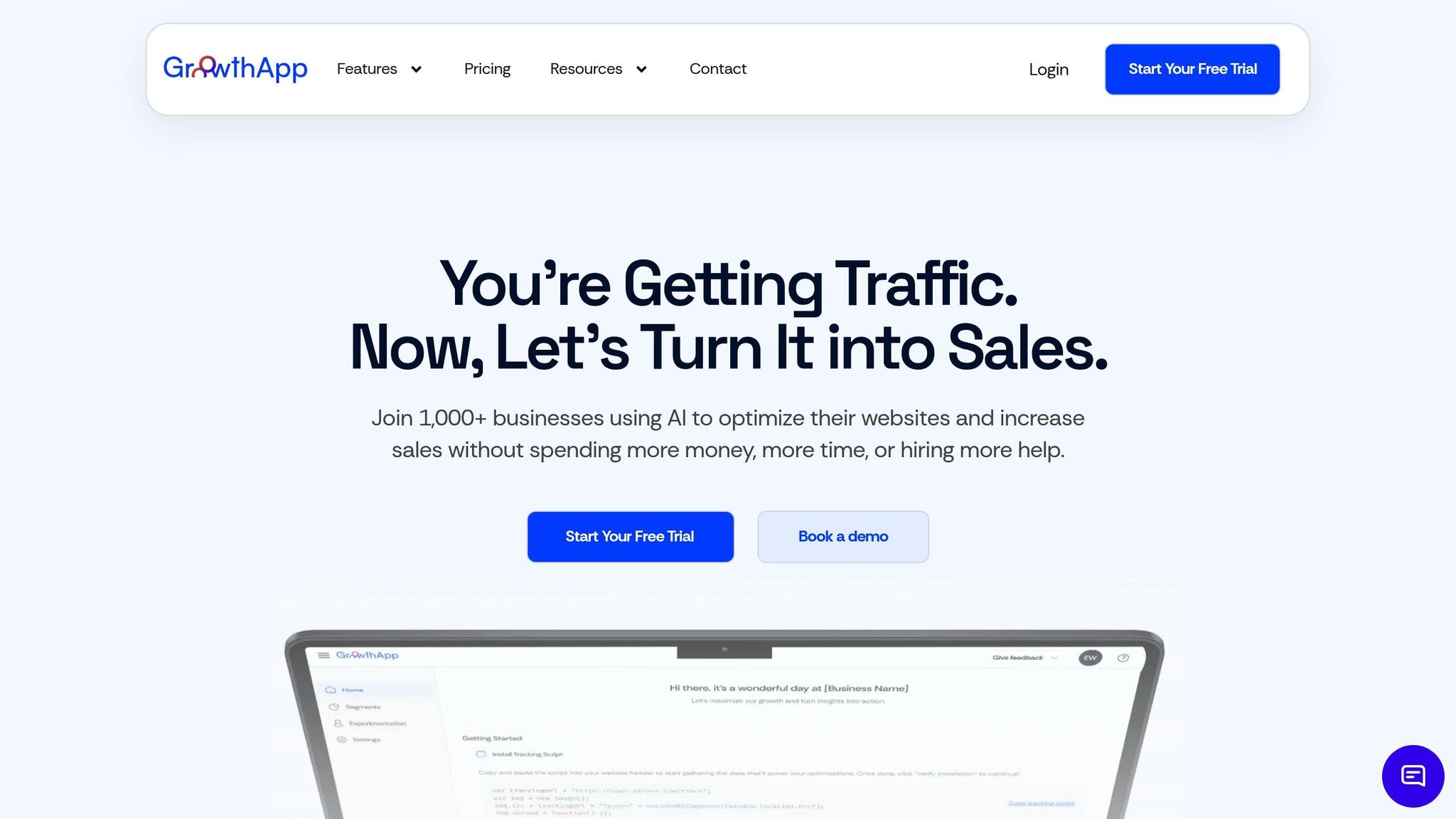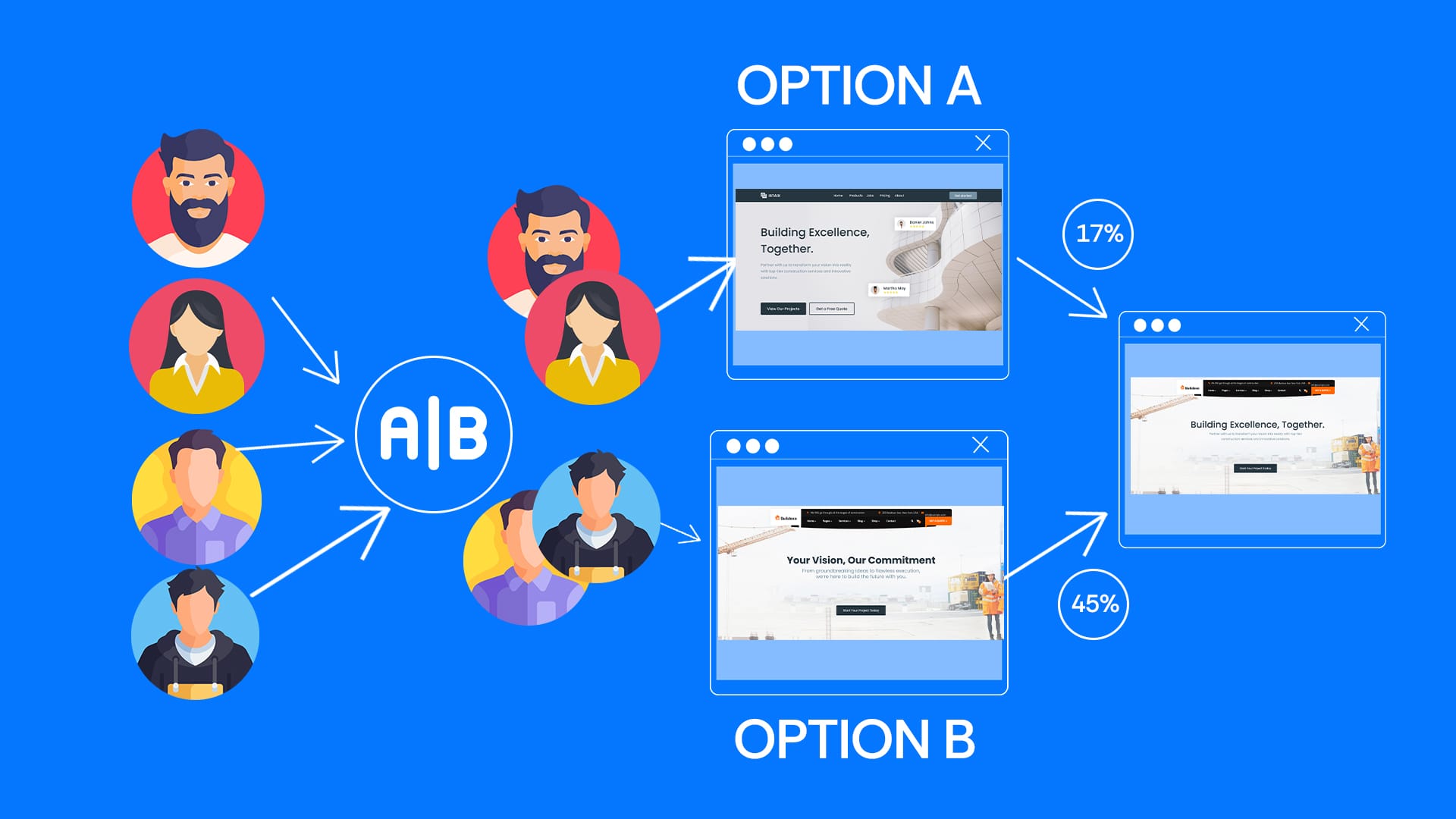AI is transforming how businesses improve conversion rates. Here’s what you need to know:
- What is CRO? Conversion Rate Optimization (CRO) focuses on increasing the percentage of visitors who take actions like purchases or sign-ups. AI makes this process faster, smarter, and more precise.
- AI’s Impact: Businesses using AI report up to a 20% boost in conversions. Examples:
- Level Nine Sports: 23.39% increase via AI-powered search.
- Hannah & Henry: 45.67% revenue growth with personalized product pages.
- HubSpot: 94% higher email campaign conversions using AI.
- Key AI Applications:
- User Behavior Analysis: AI tracks actions like clicks and scrolling to identify barriers to conversion.
- Conversion Prediction: AI predicts which users are likely to convert, helping businesses target high-intent customers.
- Personalized Experiences: AI delivers tailored content in real-time, meeting the expectations of 71% of consumers who demand personalization.
- AI Tools: Look for features like automated testing, real-time updates, and smart segmentation. Tools like GrowthApp AI simplify implementation and drive results.
Quick Comparison:
| Feature | Traditional CRO | AI-Powered CRO |
|---|---|---|
| Testing Speed | Manual, slow | Automated, fast |
| Personalization | Basic segmentation | Individualized experiences |
| Data Analysis | Human interpretation | Real-time AI insights |
| Implementation Time | Weeks/months | Days/weeks |
AI is revolutionizing digital marketing by making CRO more effective and efficient. Start by integrating AI tools, analyzing user behavior, and personalizing content to see measurable improvements in your business outcomes.
Main AI Applications in CRO
User Behavior Analysis
AI is changing how businesses track and understand visitor interactions by processing large amounts of behavioral data instantly. It examines details like mouse movements, scrolling habits, click patterns, and time spent on a page to identify obstacles to conversion and find new opportunities.
For example, Amazon uses machine learning to adjust book prices based on individual user behavior. Their AI reviews past purchases, browsing history, and engagement data to offer personalized pricing, boosting the likelihood of a conversion.
"AI in CRO refers to leveraging artificial intelligence to help drive your conversion rate." – Pritam Roy
These insights not only highlight potential issues but also power predictive models to refine the entire conversion process.
Conversion Prediction
AI’s ability to predict outcomes has reshaped how businesses anticipate and influence user actions. By analyzing historical data, AI can estimate conversion likelihood with impressive precision, helping marketers connect with high-intent users more effectively.
Salesforce integrated AI-driven predictions into its CRM system, leading to a 20% boost in sales efficiency. Here’s how AI evaluates conversion potential using various behavioral signals:
| Behavioral Signal | AI Analysis Method | Impact on Prediction |
|---|---|---|
| Time on Page | Tracks engagement in real-time | Indicates high purchase intent |
| Navigation Path | Analyzes browsing sequences | Suggests readiness to buy |
| Content Interaction | Measures depth of engagement | Reveals interest levels |
| Historical Data | Recognizes patterns | Assigns a conversion likelihood score |
These insights allow businesses to craft user experiences that are more likely to result in conversions.
Custom User Experiences
With 71% of consumers expecting tailored experiences, AI now enables businesses to deliver personalized content and recommendations at scale. A great example is Cadbury India’s campaign, which used Idomoo‘s Personalized Video platform to create custom videos featuring users’ Facebook profile pictures and names. This initiative boosted conversion rates by 33.6%.
AI-powered personalization helps businesses create real-time, dynamic experiences that match user preferences and behaviors, leading to higher conversion rates across multiple touchpoints.
Together, these AI applications turn raw data into actionable insights, helping businesses enhance user experiences and drive conversions. As AI continues to advance, it offers even more precise tools for understanding and influencing user behavior throughout the conversion process.
How AI-Driven CRO optimization is changing the game forever
AI Methods to Increase Conversions
After diving into core AI applications, let’s look at how specific AI-driven methods can help improve conversions.
Smart Audience Groups
AI has reshaped how businesses segment their audiences. By analyzing customer preferences, browsing habits, and purchase history, AI creates precise audience groups that lead to more personalized experiences – and better conversion rates.
Take Level Nine Sports, for example. By using Bloomreach‘s AI, they revamped their site search to include personalized product discovery. This led to a 23.39% increase in conversions. The system’s ability to understand synonyms and fine-tune product searches not only boosted sales but also helped clear out older inventory.
| Segmentation Factor | AI Analysis Capability | Business Impact |
|---|---|---|
| Purchase History | Identifies buying patterns | Tailored product recommendations |
| Browse Behavior | Tracks navigation paths | Personalized content delivery |
| Demographics | Analyzes user traits | Targeted promotional offers |
| Interest Signals | Monitors content interaction | Custom messaging strategies |
Once AI segments audiences, businesses can refine these insights through testing to uncover the best optimization strategies.
AI Testing Methods
AI has also made testing faster and more effective. Ashley Furniture, for instance, used AB Tasty‘s AI to test a new checkout flow. The result? A 15% boost in conversions and a 4% reduction in bounce rates.
"Since we build rapid prototypes quite often, using AI has helped us code A/B tests faster and without bugs. We’re able to produce rapid prototypes quickly, increasing our testing volume and rapidly validating hypotheses." – Jon MacDonald, CEO of The Good
Airbnb’s relevance team also saw success with AI-driven testing. They analyzed over 250 A/B test ideas, implementing 20 product changes that led to a 6% improvement in booking conversions.
Building on testing, AI can also deliver real-time updates to ensure users see the most relevant content.
Live Content Updates
Personalizing content in real time is another way AI improves conversions. Subminimal, for example, used Personizely‘s smart pop-ups to adjust content based on user behavior, achieving a 10% increase in conversion rates.
Similarly, Big Sur AI’s sales agent showed how impactful real-time updates can be. Customers interacting with the AI converted at four times the rate of average store users.
What makes real-time updates effective?
- Real-time behavior analysis: AI monitors user actions and delivers immediate, relevant content.
- Dynamic content adaptation: Experiences adjust based on the user’s current context.
These techniques combine to create responsive experiences that drive conversions while maintaining a balance between automation and human oversight.
sbb-itb-22854bb
Choosing AI Tools for CRO
Key AI Features to Look For
When selecting AI tools for CRO, focus on tools that offer features like automated testing, real-time personalization, continuous updates, and easy integration.
| Feature | Business Impact | Implementation Advantage |
|---|---|---|
| Automated Testing | Frees teams to concentrate on strategy | Automatically identifies top-performing options |
| Real-time Personalization | Can increase signups by up to 42% | Creates tailored user experiences without manual work |
| Continuous Updates | Boosts checkout conversions by 3.2x in 60 days | Applies successful changes automatically |
| Integration Options | Improves cart recovery by 30% | Works smoothly with existing tools |
These features can serve as a checklist when evaluating tools for your business needs.
How to Choose the Right Tool
When assessing AI-powered CRO tools, keep these key factors in mind to get the best return on investment:
-
Compatibility
Make sure the tool integrates well with your current marketing stack and website setup. -
Speed of Results
Look for tools that can demonstrate results quickly. For example, Happy Mammoth achieved 50 sign-ups in just two months. -
Ease of Use
Platforms should require minimal technical knowledge."We don’t have time to run constant A/B tests, and honestly, we didn’t know where to start. GrowthApp does it all automatically."
– Tucker Cohen, CEO, Smoov
GrowthApp AI: A Closer Look

GrowthApp AI is designed to boost conversions through automated segmentation and real-time behavior tracking. Here’s what it offers:
- Smart Segmentation: Uses visitor behavior data to create targeted user experiences.
- Real-time Behavior Tracking: Monitors interactions to suggest actionable improvements.
- Flexible Integration: Connects effortlessly with any website for smooth operation.
The benefits of this automation are clear, as highlighted by Shudofsky Coaching’s experience:
"It’s easy to think you need more traffic to make more money for your company. GrowthApp shows us we only need to work smarter. I think the best part is we didn’t need to do it ourselves."
– Melanie Shudofsky, Shudofsky Coaching
Choose tools that combine advanced functionalities with easy integration to achieve measurable outcomes.
AI CRO Results and Limitations
Key AI Advantages
AI-powered CRO has shown measurable improvements across multiple business areas. For example, 71% of consumers now expect personalized experiences, and AI enables this at scale. Here’s how businesses are benefiting:
- Revenue Growth: Hannah & Henry saw a 45.67% increase in revenue by using AI-optimized product pages.
- Sales Efficiency: Salesforce integrated AI into its CRM system, boosting sales efficiency by 20%.
| Advantage | Impact | Real Example |
|---|---|---|
| Personalized CTAs | 202% better performance | HubSpot’s AI-driven email campaigns increased conversion rates by 94% |
| Recommendation Engine | 35% of total sales | Amazon’s AI-powered product suggestions |
| Upsell Campaigns | 25% ARPU increase | Results from AI-backed personalization efforts |
While the benefits are clear, there are challenges that need to be addressed.
Common AI Hurdles
To get the most out of AI CRO, businesses must tackle several challenges:
-
Data Privacy and Security
Safeguarding user data is critical while ensuring AI systems remain effective. -
AI Transparency Issues
Complex algorithms can make it difficult to understand why certain optimization decisions are made. -
Human-AI Balance
Automation should be paired with strategic human oversight to avoid potential pitfalls.
Here’s how to approach these challenges:
- Data Management: Establish strict policies to protect customer data.
- Transparency Framework: Create clear processes to monitor and explain AI decisions.
- Quality Control: Maintain human oversight to ensure decisions align with the brand’s values.
AI CRO Comparison
AI-powered CRO is changing the game when compared to traditional methods. Here’s how they stack up:
| Aspect | Traditional CRO | AI-Powered CRO |
|---|---|---|
| Testing Speed | Manual A/B testing | Simultaneous multivariate testing |
| Data Analysis | Human interpretation | Real-time pattern recognition |
| Personalization | Segment-based | Individual user level |
| Implementation Time | Weeks to months | Days to weeks |
| Resource Requirements | High manual effort | Automated with oversight |
| Decision Making | Experience-based | Data-driven insights |
"AI Conversion Rate Optimization (AI CRO) is more than just a buzzword; it’s the future of digital marketing, reshaping how businesses engage with their audience and drive results." – Pritam Roy
Getting Started with AI CRO
Website Analysis
Evaluate your website’s current performance using SMART benchmarks. Here’s a quick guide:
| Assessment Area | Key Metrics to Track | Target Setting |
|---|---|---|
| Conversion Points | Conversion rate, bounce rate, exit pages | Set specific goals (e.g., "boost conversion rate by 10%") |
| User Behavior | Time on page, click patterns, scroll depth | Define engagement targets based on industry norms |
| Revenue Impact | Average order value, customer lifetime value | Establish measurable financial objectives |
These benchmarks will help you determine where and how to integrate AI into your workflow for better results.
Adding AI to Your Workflow
Incorporating AI into your CRO process requires a thoughtful approach:
-
Data Integration Setup
Link your analytics tools and CRM systems to enable seamless data tracking across platforms. -
Team Training and Adoption
Equip your team with the skills to interpret AI-driven insights and manage automated workflows effectively. -
System Integration
Apply AI across key areas, such as product pages, to improve revenue and operational efficiency.
Planning for Growth
After analyzing your website and integrating AI, focus on scaling your solutions to keep improving user experiences and staying ahead of consumer trends.
Data Privacy Framework
- Develop clear data management policies.
- Use secure data handling methods.
- Regularly review and update your data security practices.
Scalability Considerations
- Opt for tools that can grow with your business needs.
- Plan for higher data processing requirements as you scale.
- Explore options for optimizing across multiple channels.
Real-time optimization is crucial for long-term success. For example, HubSpot used AI in email campaigns and saw a 94% increase in conversion rates.
Advanced Implementation Tips:
- Keep a close eye on KPIs to track progress.
- Use advanced analytics to uncover trends and opportunities.
- Concentrate on metrics that directly influence business outcomes.
- Encourage regular team discussions to interpret results and refine strategies.
With 71% of consumers now expecting personalized experiences, your AI CRO strategy should focus on delivering tailored content and ensuring consistency across platforms.
Conclusion
Key Takeaways
AI is reshaping conversion rate optimization (CRO) by delivering measurable improvements across various industries. With 35% of businesses already using AI and another 42% exploring its potential, it’s clear that this technology is driving impactful results.
| AI CRO Component | Impact | Industry Benchmark |
|---|---|---|
| Personalization | 202% boost in performance for AI-powered CTAs | 76% of consumers are more likely to buy from brands that personalize |
| Revenue Growth | 25% increase in Average Revenue Per User | 35% of sales driven by AI recommendations |
| Testing Efficiency | 60% of companies now A/B test landing pages | 94% higher email conversion rates with AI |
These insights provide a roadmap for applying AI to your CRO efforts.
Next Steps
-
Integrate Data Analysis
Use GrowthApp AI to link your analytics tools for real-time visitor tracking and actionable insights. -
Deploy Smart Personalization
Set up AI tools with detailed customer and product data. For example, Level Nine Sports improved their conversion rate by 23.39% using AI-powered personalized site search. -
Optimize Through Testing
Leverage AI automation for systematic A/B testing. Hannah & Henry achieved a 45.67% increase in conversions by optimizing product pages with AI.
Improving CRO with AI requires ongoing adjustments and a balance between automation and human oversight. By following these strategies, you can refine your approach and achieve consistent growth in your conversion metrics.


